The following is an interview with Chris & Kell from Sailing Adrift on how to buy and renovate a boat. This American couple have spent the last three years renovating an old Nauticat boat which they picked up in 2018. The boat had seen better days when they found it, but Chris, a former restaurant owner who used to build and outfit restaurant kitchens, and Kell, who works for a building company, used their skills to give the boat a new lease on life. Here is their inspiring story and how you can do something similar.
How Did You Meet and What Inspired You to Buy and Renovate a Boat to Sail Around the World?
Kell: We met the old fashioned way, through online dating. Chris had the most gorgeous hair in his profile pictures, so he managed to sneak into my 10 year age range window and we started chatting. Things were going really well until we were about to meet up and a friend of his convinced him to cut his hair. He sent me a photo of the transition from Prince Eric to Douchebag and I found every excuse not to meet him in person.
Finally, about a month and many interesting conversations later (involving every pun under the sun) I came around. Chris had a bar in Portland and I was freelancing (bouncing back and forth from the coast, and living out of a suitcase). He asked me to swing by for Monday’s all day Happy Hour and the rest is history.
Now the boat. This whole concept was spearheaded by Chris one day. He found this article by a couple who sold everything and bought a boat to sail around the world. How romantic, right? He sent the article to me while I was at work. I was completely immersed in what I was doing but as soon as I saw the headline, “We Quit Our Jobs and Sold Everything to Travel”, I immediately switched gears. I read the article and then sat there perplexed for a while.
While I felt like I had a very open reaction to it, I sure as hell wasn’t like “hey, let’s do this tomorrow”! There’s a LOT to prepare for something like this, both mentally and physically. We decided to take our time to renovate a boat because we weren’t in a position to leave our lives yet. Well, at least I wasn’t. Chris literally put a countdown clock on his phone once we set a date.
I have traveled a decent amount but I have strong desires to see more of what’s out there. Traveling by boat, especially when it’s also your home base, makes a lot of sense to me. I consider myself a fairly minimal person, and I’ve always been drawn to the idea of living simple and small. These were my two primary justifications for saying “yes” despite not knowing anything about sailing, building a boat or life on the water.
Chris: Kell and I met while I had my restaurant, and she was working with horses and other freelance jobs. We did the online thing, chatting back and forth, but she had her hesitations for meeting, and I was plenty busy, so it took a couple months to meet in person. She came into my bar, fell for my charms, and has been caught in my web ever since – or am I caught in hers?!
The boat has been a thing I’ve always fantasized about. It’s a sexy way to see the world. When I was a high school kid, I subscribed to a yachting magazine (nerd), so the desire had always been there, it was just lying in wait. After we’d been dating for about a year, I found this article about a couple that sold everything to sail away on a boat and it woke the beast. I sent the article to Kell, and she didn’t say no – that’s a yes, right?



Was it Always Your Plan to Renovate a Boat or Did This Opportunity Just Present Itself?
Kell: We both have solid backgrounds in construction (I work for a home building company and Chris built out a few restaurants and worked for a drainage company), so buying a project boat was always the idea. We both feel comfortable working with our hands and making decisions. However, my idea of a project boat was very different from Chris’s when we started.
I had prepared myself for a pretty extensive cosmetic remodel including new electrical and plumbing. I wasn’t fully aware of Chris’s desire to design and build entire operational systems such as our water maker, a solar arch, a fuel polishing system, etc.
One obvious word of advice: to renovate a boat is nothing like doing a house. There has been a GIANT learning curve throughout this project when it comes to materials and construction methods. Nothing is ever quite level. The boat expands, contracts and sometimes plays devious tricks on you. Marine grade materials are usually harder to get or have long lead times which delay other projects. Houses are much easier! They aren’t shapeshifters.
Also, when you drop your DeWalt drill with 5 amp hour battery pack or that shiny stainless custom one of a kind fabricated fitting, you can pick it up because it didn’t fall into a dark abyss for all eternity. For the most part, houses have readily available conventional systems that you can just buy and install. And should you need help, you have several options of professionals to call. There is no manual for what we’re doing, damn near everything is a prototype.
We’ve fully embraced YouTube as an educational resource because finding trades for marine work is next to impossible. Most projects have to be done sequentially because of the tight spatial constrictions and one project usually turns into several projects – especially if you don’t have a clear game plan of how each piece comes together.
To sum up my statement, there’s a lot of trial and error involved that I did not account for but now that we’re nearing completion, it’s becoming totally worth the struggle. We both now have serious skill sets and a knowledge base that we would not have had otherwise.
Chris: Planning, early on, was not a thing. I was just going by the seat of my pants and dragging Kelly along with me. I kinda went boat shopping without her but we weren’t married, so that was okay. I found what is now our boat on the coast of Oregon 300 miles away – a sweet fixer with great bones and a big rebuilt engine.
The previous owner had passed away after spending several years with the unrealized dream of fixing it up and cruising, but not a ton had been done with the boat. A lot of the pieces were there, it just wasn’t put together. We knew we had time before we’d be able to cast the lines and go, so that project was perfect. It would keep me focused on the goal, give Kelly plenty of time to wrap her mind around the breadth of what we were doing, and we’d end up knowing everything about everything on that boat once complete.
Also, there would be no previous owners or professionals to blame should something go awry. It’s like getting a Lego Death Star with no instructions. You know roughly what it’s supposed to look like when it’s done but good luck piecing it together.
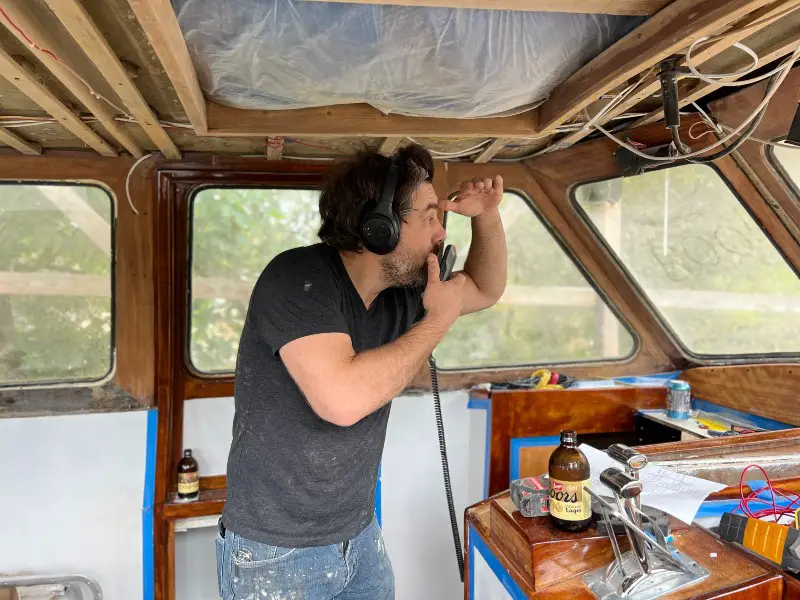
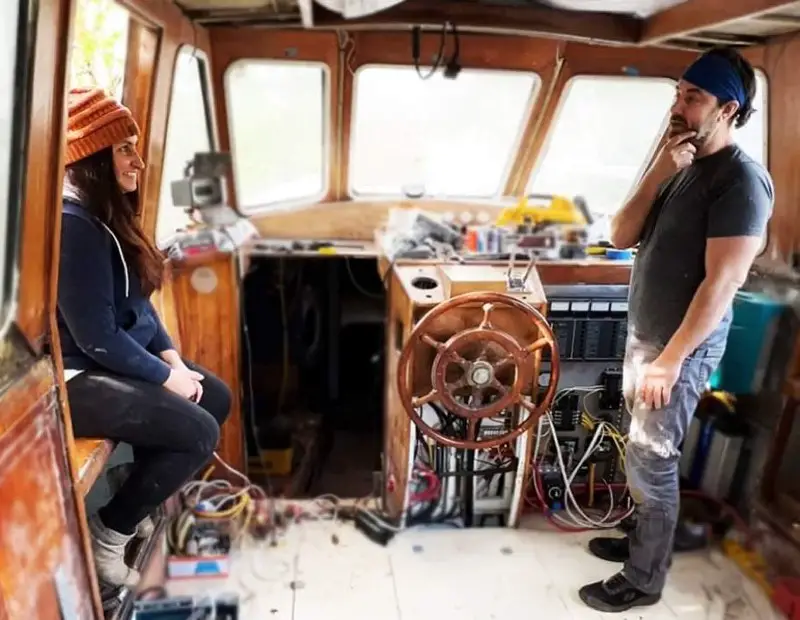
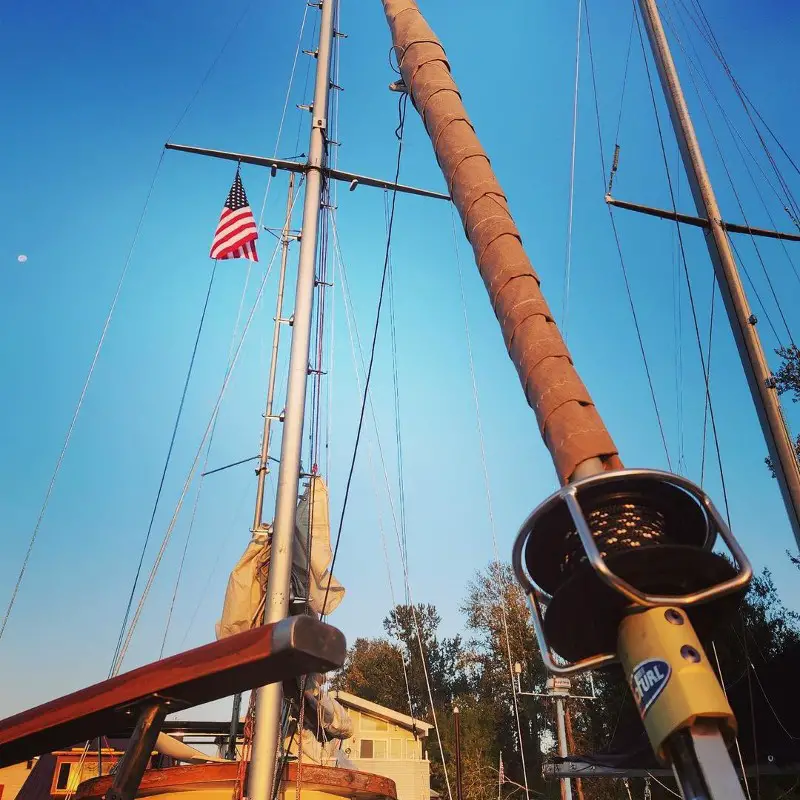
What Type of Boat Did You Buy and Why Were You Attracted to This One in Particular?
Kell: Being total beginners, we were really drawn to the idea of a motor sailor. We wanted some level of insurance in case sailing wasn’t an option. When this Nauticat popped up, we pounced pretty quickly. We knew that these boats were well made and hold their value. The engine had been recently rebuilt so even if things didn’t work out as planned, we figured we could still get our money back. I’m more of the “what-if”, “worst case scenario” person of the two of us. Chris is the dreamer. We both make it work.
Chris: Being so naïve in the world of sailing, I immediately went into research mode. I also quizzed anyone I knew that had a modicum of knowledge on the subject. This is a great way to begin, but a lot of advice you have to take with a grain of salt because the boat industry is the wild west and there are a million ways to do something right. And there are an equal number of ways to do it wrong. You can’t take everyone’s “hard and fast” rules as gospel or you’d drive yourself crazy with the sheer contradiction of information.
After hours of homework, I sat down and wrote a weighted list of wants. For us, speed and sailing efficiency took a backseat to comfort and livability. We were going to be in no hurry, and spend the vast majority of our time at anchor enjoying new peoples, cultures and locales. We wanted a boat with lots of living space for the footage and we didn’t want to break the bank on the boat at the expense of our cruising kitty.
We had lots of time to spend, saving and preparing, so the refit gave me a project I could focus on to keep myself sane during the monotony of the mundane. Our pilothouse seemed (and still seems) to check the boxes, the only question left is “how does he sail? (yes, our vessel is a he). Answering that question is up next on the agenda.
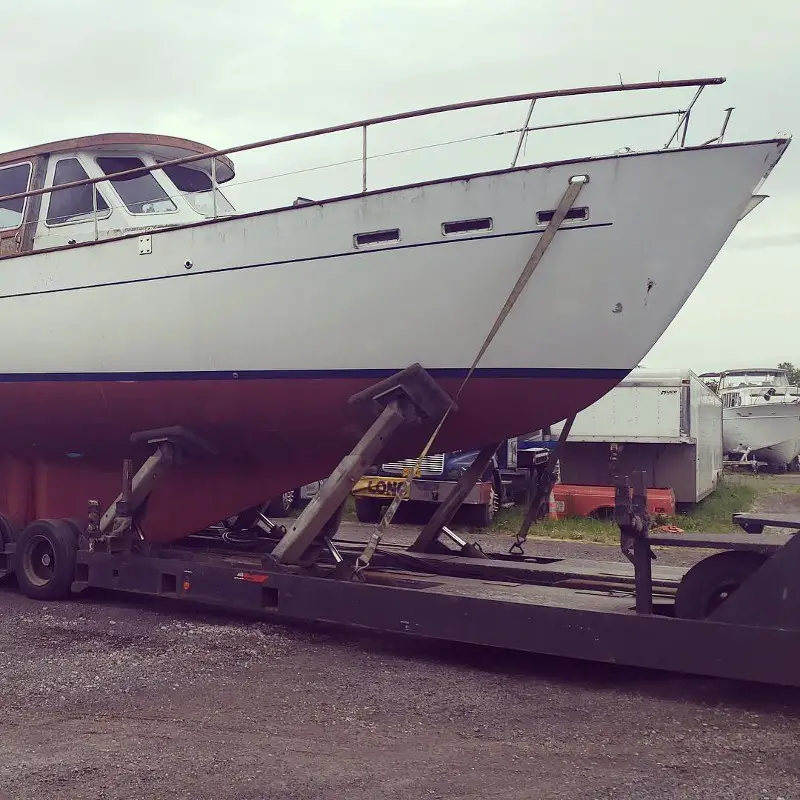
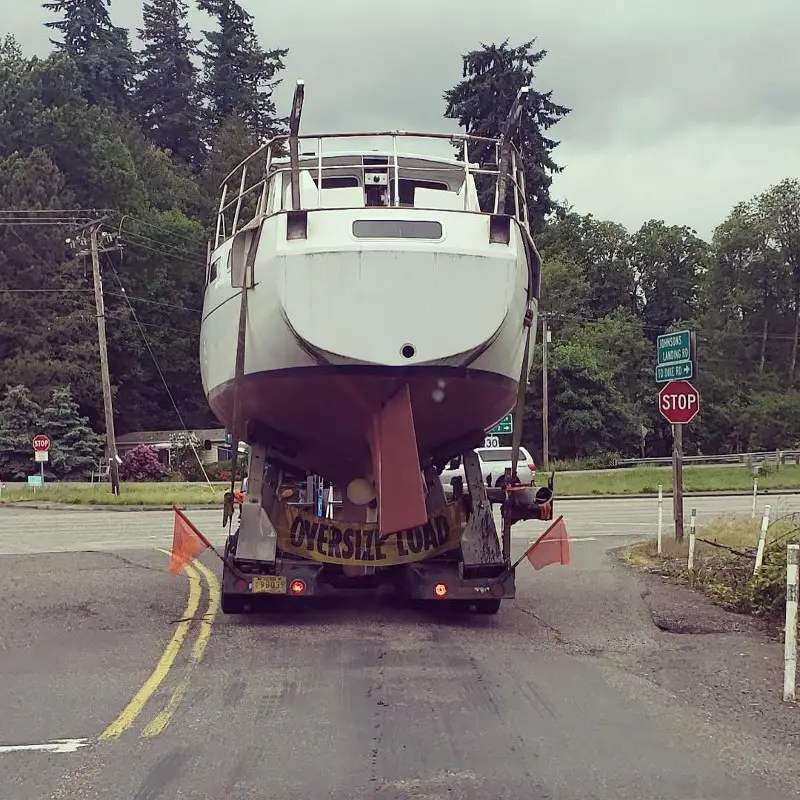
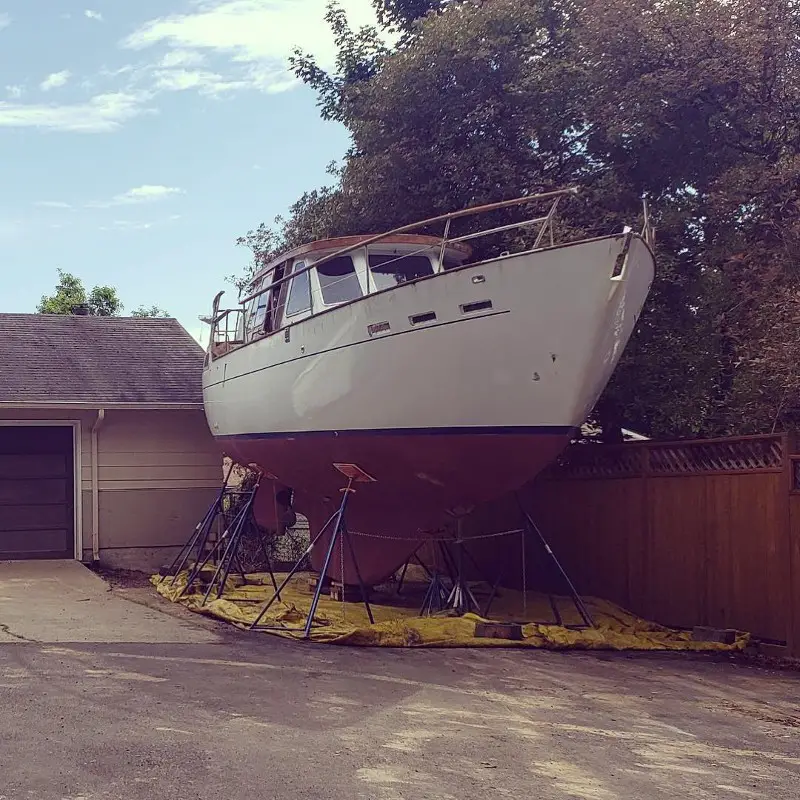
What Was the Process Like Over the Past 3 Years and Was Chris’s Experience Key to All of This?
Kell: We are both people who enjoy staying busy and thrive on constantly having a project. This has clearly been a huge undertaking and I don’t think either one of us assumed it would be easy, but we were both up for a new challenge. We purchased the boat in 2018, and started picking at it and brainstorming ideas until we got married in 2020. Then COVID hit and we both had a few large pockets of time to really get cranking. Once we got our momentum, it was full steam ahead to renovate the boat.
We have pretty equal roles in terms of the design, layout and functionality of the boat but Chris is CLEARLY the handyman. He’s a jack of all trades. He’s done all our plumbing, electrical, mechanical, refrigeration, wood working, navigation, etc. The biggest benefit to building your own boat is that you know every single part of what you did – what’s new, what’s used, what will need replacing and when. Also, there’s a huge bonus/byproduct in having a YouTube channel, and that is having everything recorded and documented!
Chris: Having the restaurant kitchen refitting experience only lent confidence in my ability to figure things out. I’ve always been pretty handy, and willing to eat an elephant, but I’m not sure where that willingness originated. We took the “divide and conquer” approach to the renovation. We separated the boat into 5 parts: the aft cabin, the forward section, the engine room, the pilothouse, then the deck and took the projects on in that order.
The aft cabin would be our room, so if it ended ugly, only we would see it. Then we went forward with our newly practiced carpentry skills to tackle the forward v-berth, head and salon. Then before we tore up the pilothouse, we made sure the engine and all the systems under the pilothouse floor were installed and operating, we took on the pilothouse and the helm, electrical and electronics hubs, and the galley last before heading outside to install all that standing and running rigging, hardware, new rails and solar arch.
We were going for a bit of a reclaimed, post-apocalyptic look for the interior which I don’t think we quite achieved. But for the exterior, we wanted the boat to look a bit shabby from a distance, but once you gave it a second look, realized it was actually very sturdy and functional. That we nailed. The outside looks like crap!
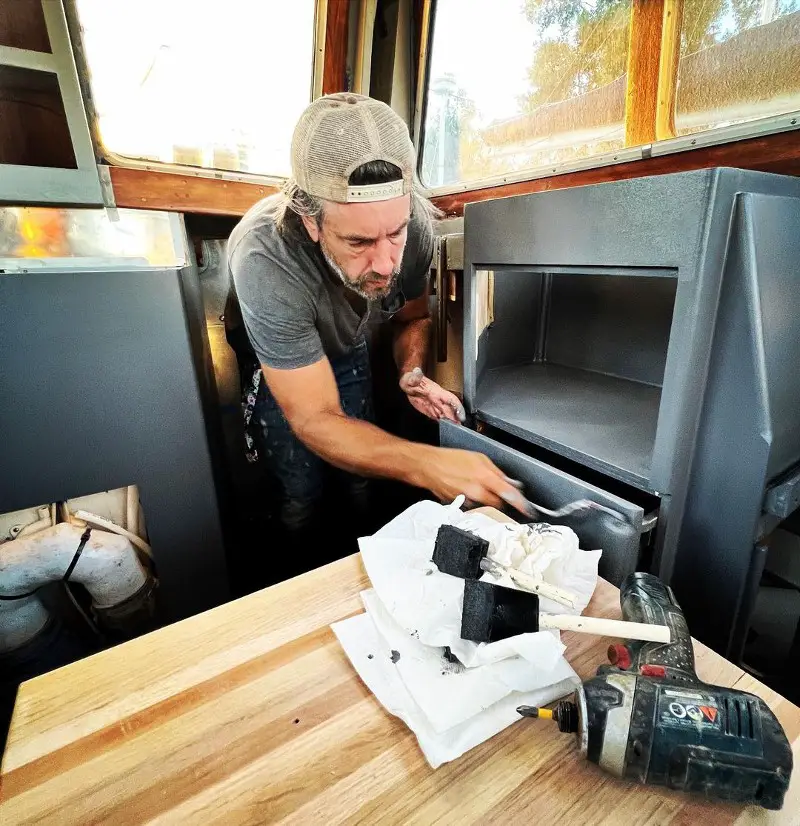
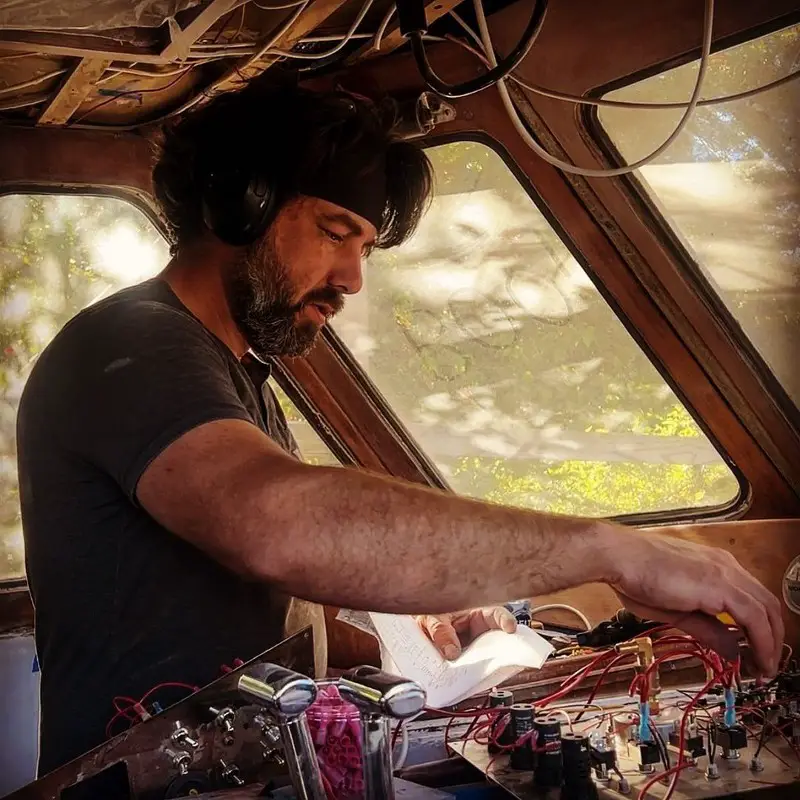
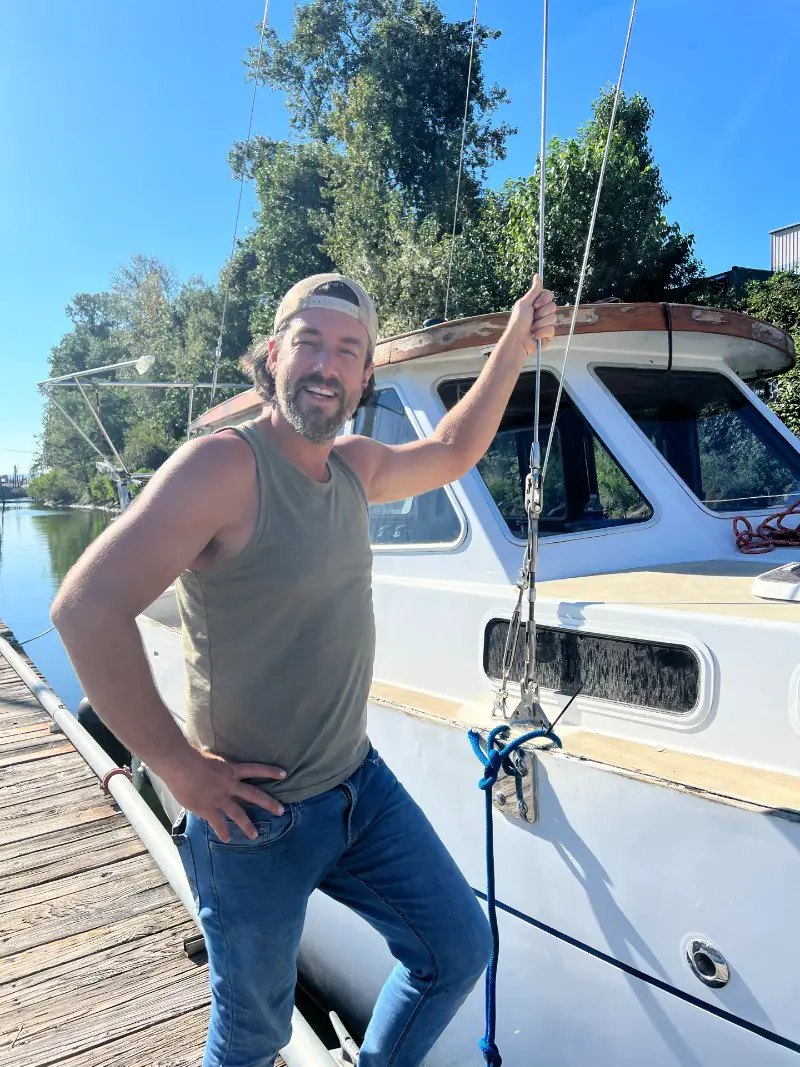
Can Anyone Buy a Boat and Renovate it or Do They Need Specific Skills?
Kell: In theory, yes – anyone can renovate a boat. But you have to REALLY want this and you aren’t allowed to give up! It depends on how much you’re willing to spend. I’m not just talking about money. I’m talking about the energy, time, blood, sweat, tears and muscle cramps you’re willing to endure to make this happen.
The other huge factor is the level of quality you want out of your project. For example, we spent a lot of time on our finishes aboard because, after all, this is our home and we knew we’d be constantly reminded of all the shortcuts if we saw them everyday. We also focused a lot on doing everything right and secure the first time, so we wouldn’t have to do it again later (or at least for a long while).
If we had a more utilitarian approach, we would definitely have reduced our costs and time, but we’d constantly be fixing or patching things along the way and that’s not what the next chapter is about! Prior to the renovation, we knew quite a bit about residential construction methods and how things come together but almost everything we’ve learned since the refit has been through online research, trial and error.
There are a few things we had to call in the big guns for (like making sure we wired up the engine correctly). Other than that, I’d consider us “self taught”. So yes, if you’re motivated enough, you can teach yourself how to do just about anything. Pair that with perseverance and you can renovate a boat too!
Chris: As long as you are relatively able bodied, this type of an undertaking is more about mindset than skillset. And you need a huge dose of perseverance. I think what will separate success and failure is seeing the whole project through without giving up. I’ve done and redone several things on this boat, and I’ve had waxing and waning levels of motivation as we’ve progressed. You have to keep pushing or you’ll never finish.
It took us 3 years to renovate the boat and literally thousands of hours to get where we are. If you had all day, everyday to do it, you could get this done in half that time, but it may take you 3 times as long as it took us. Whatever you do, you just have to keep going. I tell Kelly that I’ve loved this overall process and what we have to show for it, have hated almost every job I’ve had to do on this boat and have no desire to do it all again anytime soon.
As far as paying someone else to do this and still saving money, that’s absolutely not possible. The cheapest way to get a blue water ready boat is to let someone else empty their wallet, then buy it from them as close to being ready as possible. And the overall cost between refitting yourself and buying a refit boat is not even close.
We spent just into the 6 figure mark on this whole process and that doesn’t compensate us a nickel for the 3,000+ hours of work (that’s over 75 weeks of a fulltime job)! If you were to go out and find a “comparable” boat ready to take on oceans, my guess would be you could do it for $100,000 pretty easily but it won’t be as cool as ours.
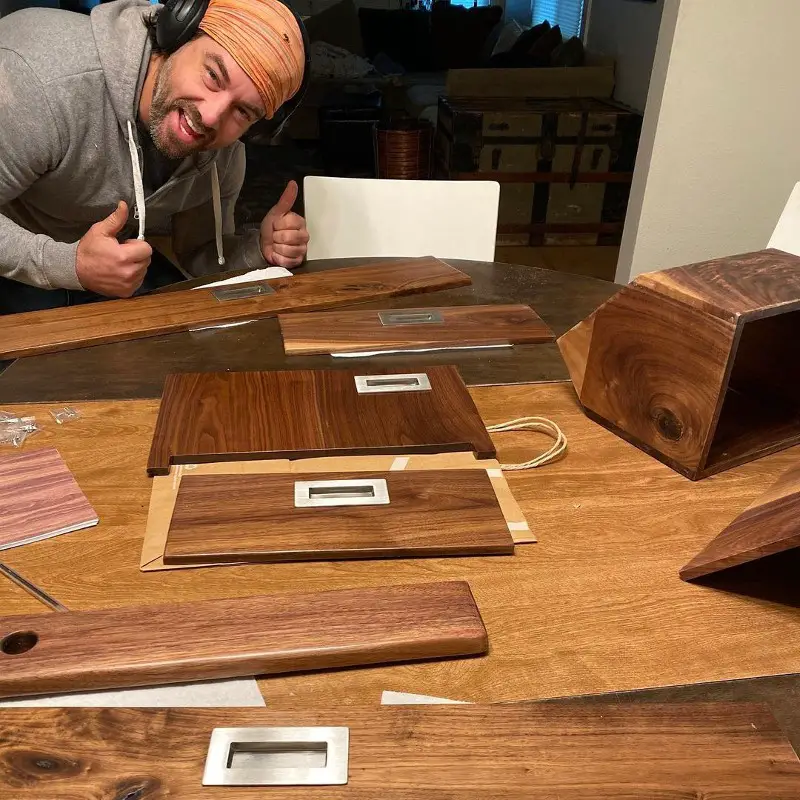
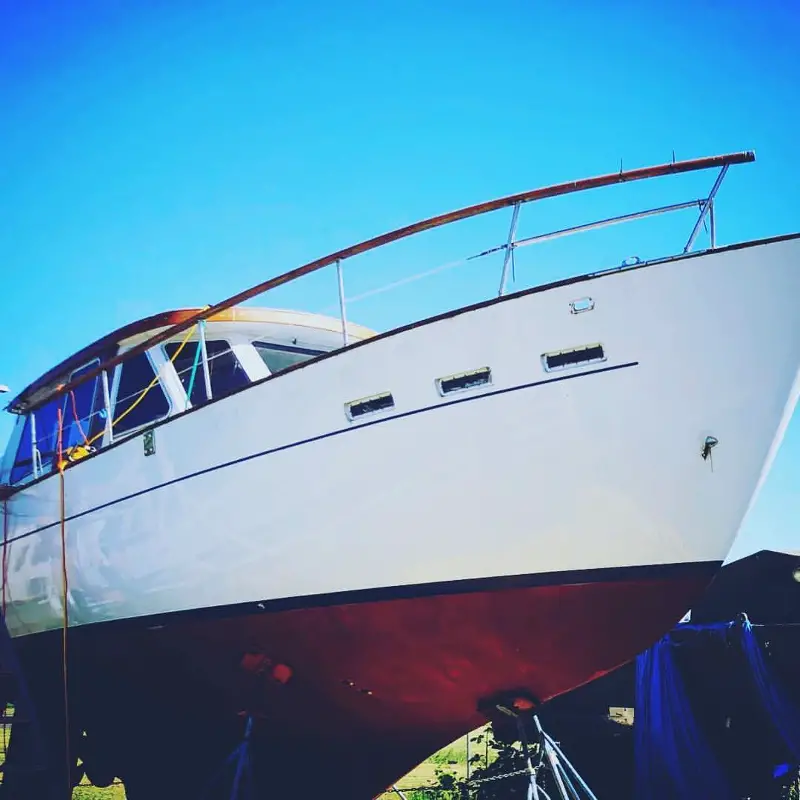
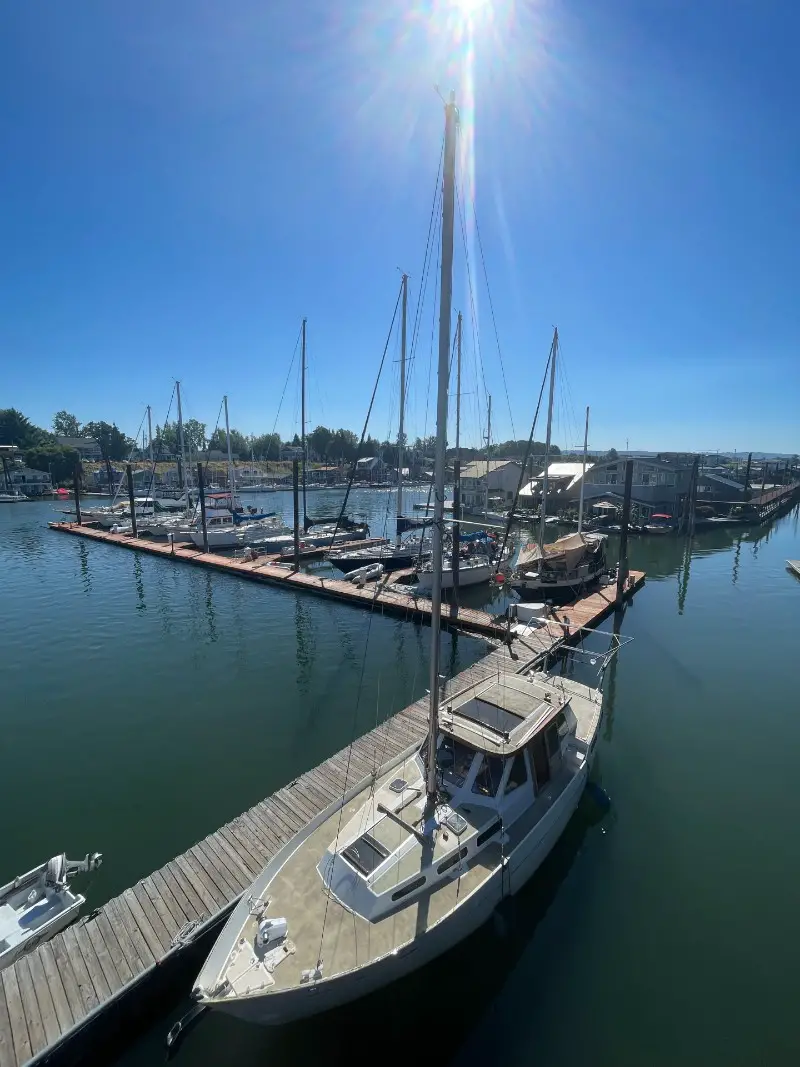
How Expensive is it to Renovate a Boat? Was it More or Less Expensive Than What You Originally Thought?
Kell: Everything ‘boat’ is expensive. Anyone who has anything to do with a boat will tell you that all day long – it’s no secret. We knew that to renovate a boat was going to be an expensive endeavor, so we did a lot of homework on systems and materials throughout the process to make sure we got the quality we wanted for the value we could afford without cheaping out.
Again, if we had a more utilitarian approach of just making the boat seaworthy, we obviously would not have invested so much. But our goal was to make this vessel a comfortable home and a safe method of transportation. So the investment was much higher than it could have been. I don’t think we necessarily saved any money by doing a refit vs. buying something ready to go.
However, we did learn a lot and now have a pretty extensive knowledge base on what to do and how to fix things in the future, which will definitely save us money later on. I will say, if you can find someone credible to renovate your boat at a reasonable price and they actually show up, hang on to that contact because he/she is so rare they’re worth GOLD! But you’re not going to save any money.
Chris: My original, naïve guess at this project (and I don’t have my old notes for proof) is that all in all we would spend about $100,000 on the project to have a boat (that we know inside and out, which is the real value of doing this yourself) that would be worth about $150,000. I would say now my guess on the project costs is within $10k of my original guess of $100,000, and as it is right now, we’d be able to sell him for $80,000 – $100,000.
But, if we spent another $5 – $10,000 to beautify the exterior, I think we’d be a lot closer to my original estimate of $150,000 assuming an average market climate. One of the reasons we picked our Nauticat is because they have a stellar reputation for strength, comfort and dependability – and because of all of that, they hold their value very well. He’s blue water and off-grid ready, and that isn’t so easy to find.
As I mentioned before, the way to get the best bang for your buck is to go out and find the unicorn that is in great shape, and the former owner has already made all the upgrades (and the upgrades aren’t too terribly out of date) on a boat made for oceans. You’ll end up spending a bit after the purchase outfitting her and making her your own, but not the thousands you will refitting.
There’s a boat for every budget and people have crossed oceans on rafts. I would say to grab a safe, comfortable boat that has all the things you’d need to sail the seven seas, you’d need a minimum of $50k for the boat purchase, but plenty have done it on much less.
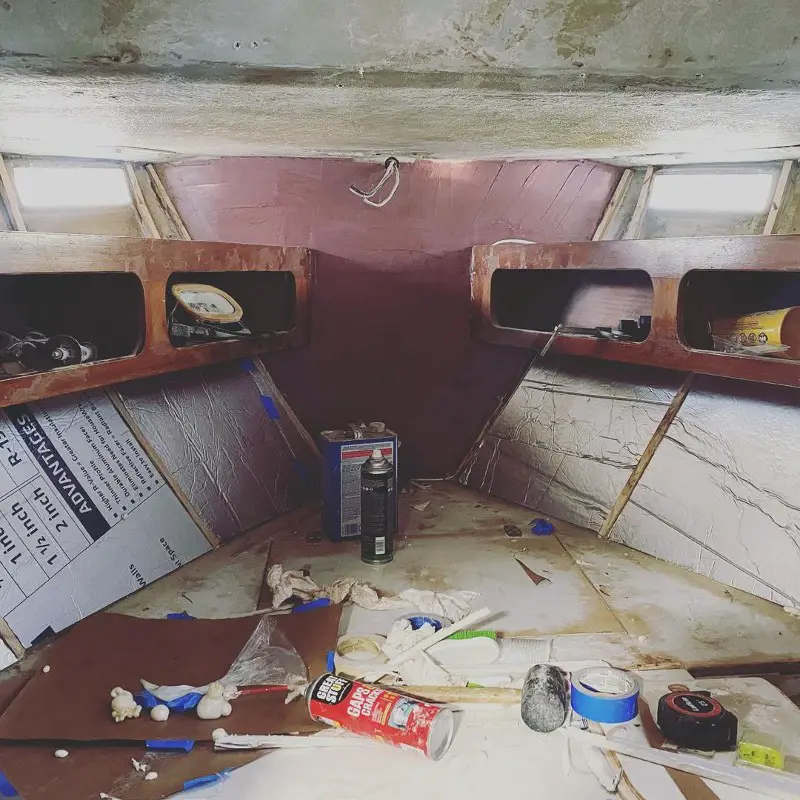

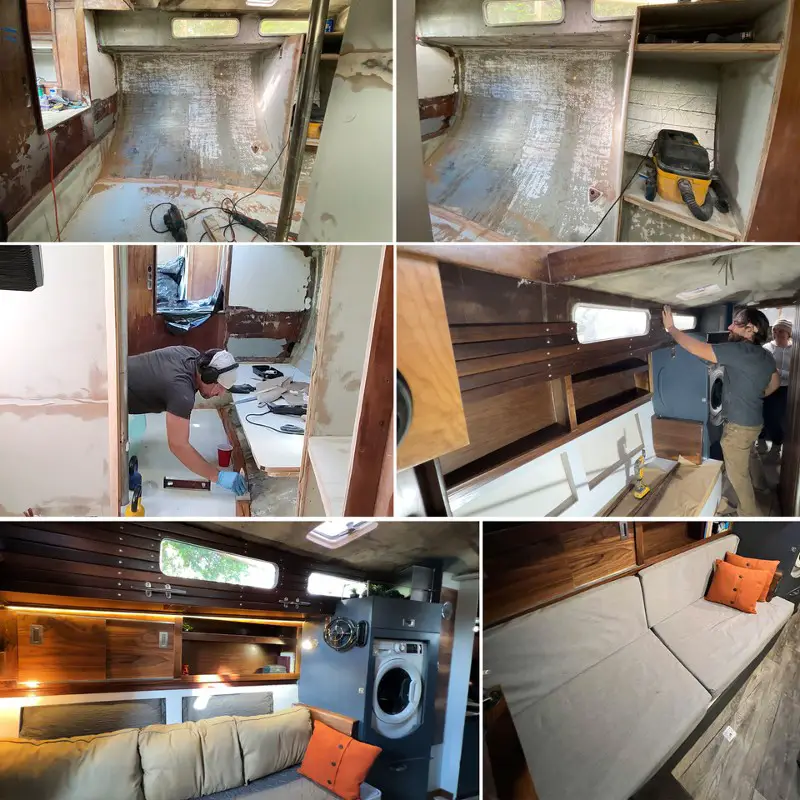
What Things Did You Install, Renovate and Change to Turn Your Boat Into a Shipshape Vessel?
Kell: You know that phrase, “It’s what’s on the inside that counts”? That pretty much describes our boat. The exterior didn’t change (or at least it hasn’t yet), but we gutted everything on the inside and it’s been totally transformed. The layout is completely reconfigured – I don’t believe anyone would recognize this boat as a Nauticat. We put our galley up into the pilothouse, the salon is now a huge hangout area with a projector screen and two additional berths.
We’ve done everything to maximize each square inch of this space and we’re pretty proud of how it all turned out. We have two heads, two cabins and more stowage spots than we know what to do with! Chris built us a cute little robot that functions as a lamp, he has two USB ports in his tummy and he also dispenses rum from a hidden tank behind him.
We built one of our three refrigerators using vacuum insulated panels, a media cabinet with an integrated sound system, a freshwater tank that holds 130 gallons right over our keel, and just about every void (bench, floor and staircase) also doubles as a stowage. The rigging is finally up (after 15 years of being on the hard), we assume that’s all the same. The brightwork and deck are original. The only big structural thing we added to the exterior was our solar arch. That was like a whole project in itself but that’s a different story.
Chris: It might be easier to list what we didn’t change or renovate on the boat! The engine came installed but had no fuel or exhaust connections. The major structural (bulkheads, stringers, pilothouse floor and hatches) are all original, and for the most part, the deck is the same.
But I reconfigured the bow, relocated the chain locker, reused the forward stations but replaced the cap rail and rail after waterproofing the gunnels, replaced the aft railing and added a solar arch to the original davits, installed new winches, roller furler, reefing system and sail covers.
I also installed new controls for the engine, redid the electrical and electronics, removed a genset and replaced with a new battery bank, added a watermaker, redid the plumbing, heads, tankage, and completely gutted and rebuilt the interior and layout with the exception of the helm which we just refinished but is largely original. It’s been a project.
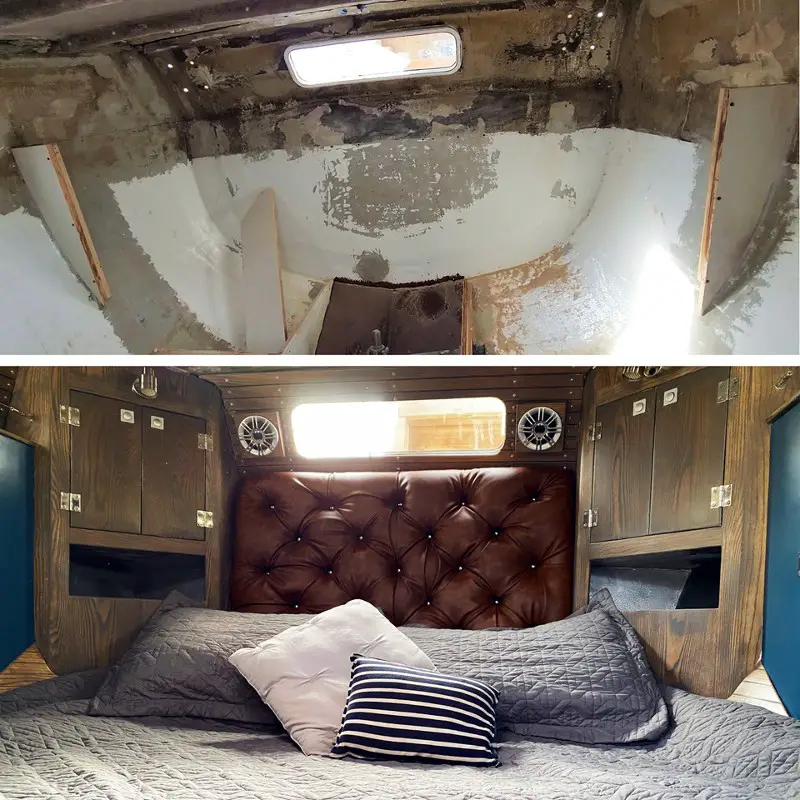
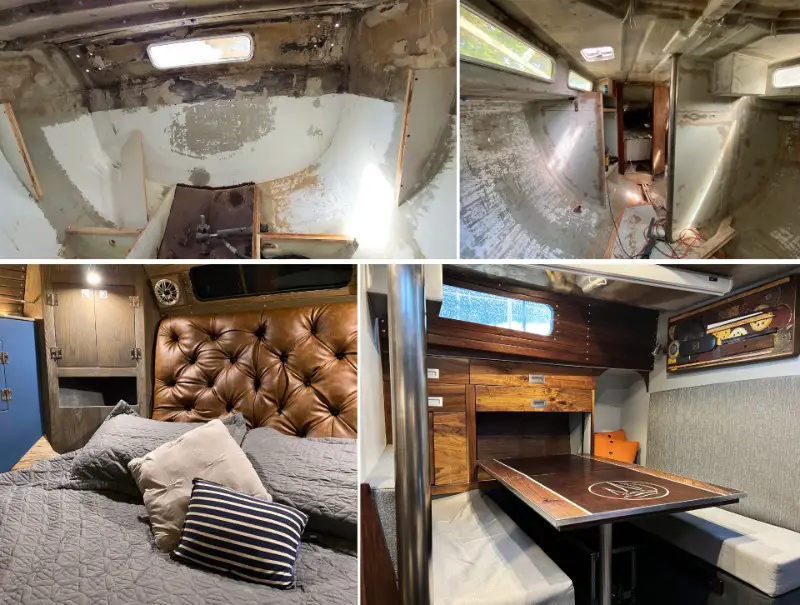
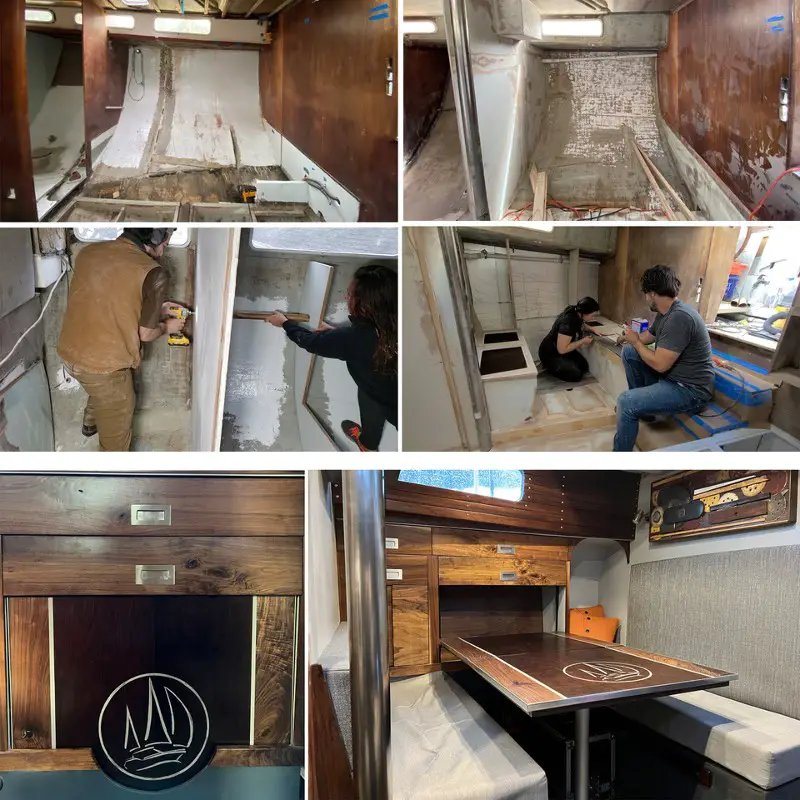
When Will You Start Sailing? Where Do You Plan on Going and What Routes Will You Be Taking?
Kell & Chris: A month ago! We are ready to start as soon as we get a decent weather window, because the Pacific coast this far north is no joke. Our first leg will be out of the bar in Astoria and down the Oregon coast to California. Once we get to California, we’ll take our time cruising to Mexico exploring the Gold Coast and Baja. After that, who knows. The plan is to keep going while the kitty holds out (this will probably be our weak point), or until it isn’t fun and exciting anymore, but the overarching plan is to see the world!



What is the Number One Thing You Are Looking Forward to About Sailing Around the World?
Kell: I’m looking forward to the lifestyle, not any place specific, just day to day life. Experiencing new places without a time frame and moving to a new place when we feel like it. I think we’re both getting very anxious now that the boat is complete. After these last few years, it’s finally time to cash in on all of our effort!
A big contribution of mine in this project has been the YouTube channel, and I really enjoy documenting what we do and creating stories. We have over a hundred episodes and we’ve been consistently creating memories every week since 2019. I am very excited about transitioning out of a refit channel and into a real travel/sailing channel. I’m really looking forward to creating those kinds of stories because those are the types of stories that inspire me.
Chris: My glib response to the question “what is your favorite restaurant?” has always been “the one I haven’t been to yet”. I’m sure that will translate into our adventure around the world. When I think back to my time punching a clock and doing the same thing week after week, I remember nothing. Whole periods of my life are missing because my brain couldn’t be bothered to file away the same thing over and over and over.
What I do remember is all the experiences that varied from the monotony, both the good and the bad. Those unique experiences are what makes for a rich and full life, so that is what I look forward to the most. That every day has the potential to present unique experiences and lasting memories. That seems to me to be the best way to experience your one shot at life.























